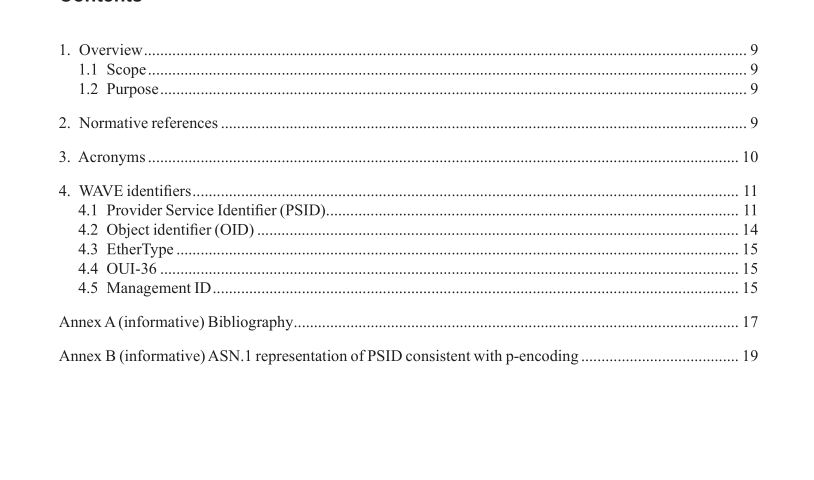IEEE 1609.12-2016 pdf download.IEEE Standard for Wireless Access in Vehicular Environments (WAVE)—Identifer Allocations
4.1.2 P-encoding of PSIDs format This standard defines a compact encoding for PSID referred to as p-encoding. Octets are numbered from the left starting at zero (Octet 0) The PSID format is specified in IEEE Std 1609.3.
The most significant bit(s) indicate. The length of the PSID field is indicated by Octet 0, where the position of the first zero-value bit in descending order of bit significance in the octet indicates the length in octets of the p-encoded PSID. Using p-encoding, a binary “0” in the most-significant bit indicates a one-octet PSID; a binary “10” in the two most-significant bits indicates a two-octet PSID; a binary “110” in the three most-significant bits indicates a three-octet PSID; and a binary “1110” in the four most-significant bits indicates a four-octet PSID. In this document, p-encoded PSID values (in hexadecimal form) are preceded by “0p” rather than “0x” to distinguish them from PSID values that are not p-encoded. In Table 1, the final column provides equations that allow conversion between PSID values (represented here by “V”) and their p-encoded values (represented here by “P”).
As a consequence of the length encoding in the first bits of Octet 0 in every p-PSID, only PSID integer values from decimal 0 (0x00-00-00-00) to decimal 270 549 119 (0x10-20-40-7F) can be encoded in p-encoded PSIDs of length less than five octets. As a further consequence of the length encoding, not all octet strings are valid p-encoded PSID values. While p-encoded PSIDs of a given size are sequential, the transition from one length to the next involves skipping a number of hexadecimal values as indicated in Table 1.
For example, the p-en-coding of PSID 127 is 0p7F while the p- encoding of PSID 128 is 0p80-00. Consequently, hexadecimal values between 0x80 and 0x7F-FF are not valid p-PSID values. The p-encoded PSID format specified is compliant with the ITS-AID format specified in ISO TS 17419 [B14]. Annex B gives ASN.1 structures that, when encoded with the Unaligned Packed Encoding Rules of ISO/IEC 8825-2 [B9], produce output that is bitwise compatible with p-encoding.
Note that in IEEE Std 1609.3-2010 and IEEE Std 1609.12-2012, PSID was specified in terms of what is referred to in this standard as the p-encoded value.
4.1.3 PSID allocations Table 2 represents At the time allocated PSID values as of the publication date of this standard. For up-to-date information on assignments, see the 1609 PSID page at the IEEE Standards Association Registration Authority website: http://standards.ieee.org/regauth. PSID values allocated to ISO are consistent with the list of ITS-AIDs published in ISO standards including ISO 15628.
A PSID value allocated to the IEEE 1609 working group (WG) for testing purposes is not identified with a standard application area. It is expected to be used only in testing environments, not to convey information about deployed applications. The meaning associated with a given testing PSID value will be specific to the testing environment in which it is used. The means by which a WAVE device determines the meaning of a testing PSID value are outside the scope of this standard.
A reserved PSID value is not available for allocation in the current version of the standard. The IEEE 1609WG may allocate the reserved values in a future version.
A PSID value allocated to the IEEE 1609 WG for private use is not identified with a standard application area. A set of WAVE devices can use a private value to convey a mutually agreed meaning. Both the meaning and the means by which the devices determine the meaning are outside the scope of this standard. There is no guarantee assurance that all devices operating in a given area attach the same meaning to the value.IEEE 1609.12 pdf download.IEEE 1609.12-2016 pdf download
IEEE 1609.12-2016 pdf download

Leave a Reply